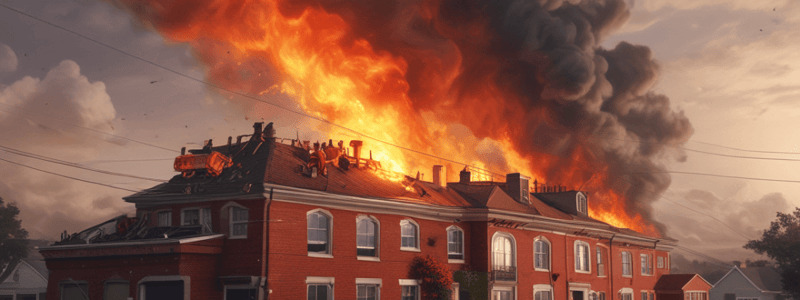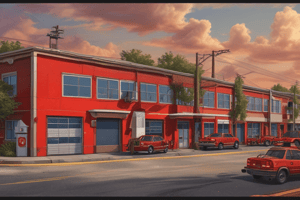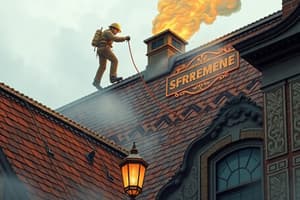Podcast
Questions and Answers
What is the primary objective of establishing a Roof Sector during offensive fire operations?
What is the primary objective of establishing a Roof Sector during offensive fire operations?
- To evaluate roof conditions and complete vertical ventilation (correct)
- To provide an emergency exit route for firefighters
- To deploy defensive operations against the fire
- To provide a secondary means of escape for victims
Where should ladder companies be strategically placed during Roof Sector operations?
Where should ladder companies be strategically placed during Roof Sector operations?
- On the opposite side of the building to ensure a clear escape route
- At the entrance of the building to coordinate with incident command
- Near the location of the fire to provide immediate support
- In tactical positions to permit effective defensive operations if needed (correct)
Who is responsible for supervising Roof Sector crews?
Who is responsible for supervising Roof Sector crews?
- The incident commander
- The first personnel reaching the roof
- Company or chief officers (correct)
- The crew members themselves
What is a critical safety consideration for Roof Sector operations?
What is a critical safety consideration for Roof Sector operations?
What is the purpose of the Central Arizona Life Safety System Response Council (CALSSRC) standard operational procedure?
What is the purpose of the Central Arizona Life Safety System Response Council (CALSSRC) standard operational procedure?
Why is it important to maintain a constant re-evaluation of roof safety throughout Roof Sector operations?
Why is it important to maintain a constant re-evaluation of roof safety throughout Roof Sector operations?
What should Roof Sector personnel consider when evaluating the roof conditions?
What should Roof Sector personnel consider when evaluating the roof conditions?
What is a key responsibility of the Roof Sector?
What is a key responsibility of the Roof Sector?
What is the primary purpose of specifying the type and size of vent holes in roof operations?
What is the primary purpose of specifying the type and size of vent holes in roof operations?
What is the main difference between commercial and residential roof systems?
What is the main difference between commercial and residential roof systems?
What is the primary objective of the Roof Sector Officer?
What is the primary objective of the Roof Sector Officer?
Why should additional holes be cut in a roof during ventilation?
Why should additional holes be cut in a roof during ventilation?
What should be done when a vent hole is completed?
What should be done when a vent hole is completed?
Why should the Roof Sector Officer constantly evaluate the structural stability of the roof?
Why should the Roof Sector Officer constantly evaluate the structural stability of the roof?
Flashcards are hidden until you start studying
Study Notes
Roof Sector Responsibilities
- Establish a Roof Sector during offensive fire operations to evaluate roof conditions and complete vertical ventilation
- Roof Sector officer must supervise crews and ensure safe operations
- Crews must enter the roof from an established safe area and have a secondary means to escape or reach a safe refuge on an unexposed and structurally sound roof surface
Roof Conditions Evaluation
- Evaluate roof conditions to assure structural soundness before attempting to work on it
- Consider the degree and extent of any signs of weakness before committing personnel above the fire
- Constantly re-evaluate roof safety throughout roof operations
Roof Sector Objectives
- Determine a safe working surface
- Complete ventilation cuts to achieve effective ventilation
- Coordinate/Communicate roof (vertical) ventilation with interior crews
- Coordinate roof fire control operations as directed by Command
- Maintain roof-top monitoring of roof structure and fire conditions
Commercial vs. Residential Roof Systems
- Distinct differences in construction design between commercial and residential roof systems
- Aware of differences that potentially impact roof operations
Special Roof Types
- Bowstring Roofs: no firefighter shall operate on or under a bowstring roof if the fire has penetrated the attic, involves the trusses, or the structure
- Metal Roofs: evaluate the pitch of the roof to determine if it is too steep to safely operate on
- Residential Tile Roofs: no firefighter shall operate on the roof of a residential structure fire covered with concrete roof tiles
- Commercial Tile Roofs: follow CALSSRC's standard operation for safe and efficient vertical ventilation operations
Roof Sector Duties
- Report to Command on roof design and construction, decking material, structural conditions, smoke/fire conditions, locations of fire walls and skylights, and heavy objects affected by fire conditions
- Provide progress reports to Command, including presence or absence of fire in the attic, smoke conditions, and changes in roof conditions and/or structural stability
Studying That Suits You
Use AI to generate personalized quizzes and flashcards to suit your learning preferences.




